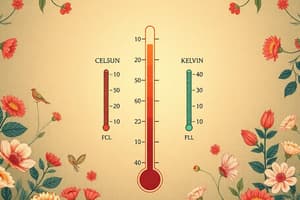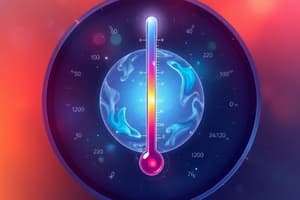Podcast
Questions and Answers
What is the typical temperature for a warm bath in Fahrenheit?
What is the typical temperature for a warm bath in Fahrenheit?
- 180°F
- 140°F
- 212°F
- 104°F (correct)
Which chemical element is considered the backbone of all organic molecules?
Which chemical element is considered the backbone of all organic molecules?
- Nitrogen
- Carbon (correct)
- Hydrogen
- Oxygen
What is the boiling point of water in Fahrenheit?
What is the boiling point of water in Fahrenheit?
- 100°F
- 220°F
- 180°F
- 212°F (correct)
Which temperature indicates a typical room environment in Fahrenheit?
Which temperature indicates a typical room environment in Fahrenheit?
Which of the following temperatures corresponds to the freezing point of water?
Which of the following temperatures corresponds to the freezing point of water?
What role do chemical tests like blood and urine analysis play in medical practice?
What role do chemical tests like blood and urine analysis play in medical practice?
At what temperature is ice cream typically stored in Fahrenheit?
At what temperature is ice cream typically stored in Fahrenheit?
Which element is essential for both water and the composition of organic molecules?
Which element is essential for both water and the composition of organic molecules?
Who proposed the ancient atomic theory in the 5th century?
Who proposed the ancient atomic theory in the 5th century?
According to the Rutherford atomic model, where is most of the mass of an atom found?
According to the Rutherford atomic model, where is most of the mass of an atom found?
What term did Rutherford use to describe the paths the electrons take around the nucleus?
What term did Rutherford use to describe the paths the electrons take around the nucleus?
What significant advancement in atomic theory occurred in the 1920s?
What significant advancement in atomic theory occurred in the 1920s?
What can be said about the mass of protons and neutrons compared to electrons?
What can be said about the mass of protons and neutrons compared to electrons?
What was a major contribution of Erwin Schrödinger to atomic theory?
What was a major contribution of Erwin Schrödinger to atomic theory?
If the size of the nucleus is compared to a blueberry, how large would the entire atom be?
If the size of the nucleus is compared to a blueberry, how large would the entire atom be?
What particles make up the nucleus of an atom?
What particles make up the nucleus of an atom?
What does the law of conservation of mass assert?
What does the law of conservation of mass assert?
Which principle explains why electrons do not crash into the nucleus of an atom?
Which principle explains why electrons do not crash into the nucleus of an atom?
Which of the following chemical formulas represents a compound?
Which of the following chemical formulas represents a compound?
What impact did high-speed supercomputers have on atomic research?
What impact did high-speed supercomputers have on atomic research?
According to the law of definite proportions, if a substance is broken down, what remains consistent?
According to the law of definite proportions, if a substance is broken down, what remains consistent?
What is the typical mass of a neutron in atomic mass units (amu)?
What is the typical mass of a neutron in atomic mass units (amu)?
Which of the following symbols indicates a positive electrical charge?
Which of the following symbols indicates a positive electrical charge?
What does the atomic mass unit (amu) measure?
What does the atomic mass unit (amu) measure?
What is the primary function of radar in the context of electromagnetic waves?
What is the primary function of radar in the context of electromagnetic waves?
At what speed do light waves travel in a vacuum?
At what speed do light waves travel in a vacuum?
Which portion of the electromagnetic spectrum can the human eye detect?
Which portion of the electromagnetic spectrum can the human eye detect?
What does the Bohr model primarily describe?
What does the Bohr model primarily describe?
What phenomenon occurs when an electron transitions from an outer orbit to one closer to the nucleus in the Bohr model?
What phenomenon occurs when an electron transitions from an outer orbit to one closer to the nucleus in the Bohr model?
Who proposed the quantum theory in 1900, and what was its primary purpose?
Who proposed the quantum theory in 1900, and what was its primary purpose?
Which application uses radio waves to create connections between devices?
Which application uses radio waves to create connections between devices?
What is the main focus of optics in relation to electromagnetic waves?
What is the main focus of optics in relation to electromagnetic waves?
What is the primary purpose of using a balance in scientific measurements?
What is the primary purpose of using a balance in scientific measurements?
How is density defined in a scientific context?
How is density defined in a scientific context?
Which of the following units is commonly used for measuring density?
Which of the following units is commonly used for measuring density?
What is the significance of significant figures in density calculations?
What is the significance of significant figures in density calculations?
Which instrument is typically used to measure the volume of a liquid?
Which instrument is typically used to measure the volume of a liquid?
What form of energy is associated with the motion of an object?
What form of energy is associated with the motion of an object?
Which of the following best describes thermal energy?
Which of the following best describes thermal energy?
Which scientific instrument is most appropriate for measuring length?
Which scientific instrument is most appropriate for measuring length?
Flashcards are hidden until you start studying
Study Notes
Temperature Conversions
- Normal human body temperature is 98°F or 37°C
- Room temperature is 68°F or 20°C
- Water boils at 212°F or 100°C
- Water freezes at 32°F or 0°C
- Formula to convert Fahrenheit to Celsius: ℃= 𝐹 − 32 × 5/9
Temperatures in Daily Life
- Refrigerator temperature: 37°F
- Room temperature: 72°F
- Freezer temperature: -10°F
- Hot coffee: 180°F
- Body temperature: 98.6°F
- Oven temperature (medium heat): 350°F
- Ice cream freezer: -20°F
- Warm bath water: 104°F
- Air conditioner: 60°F
- Boiling water: 212°F
- Slurpee: 32°F
- Hot chocolate: 140°F
- Hot dog: 160°F
- Iced coffee: 40°F
- Frozen pizza: 0°F
- Chilled soda: 39°F
- Ice cream sandwich: -15°F
- Fresh milk: 40°F
- Bottled water from the refrigerator: 45°F
- Coffee from the coffee machine: 190°F
Chemical Composition of the Human Body
- Oxygen: The most abundant element in the body, vital for respiration and energy production
- Carbon: The backbone of all organic molecules, including proteins, carbohydrates, lipids, and nucleic acids
- Hydrogen: A key component of water, which makes up a significant portion of the body.
- Nitrogen: A crucial element in proteins and nucleic acids, essential for cell growth and function
Role of Chemical Reactions in Medical
- Drug Action: Medicines interact with specific molecules within the body to achieve their therapeutic effects.
- Diagnostic Testing: Chemical tests like blood and urine analysis help diagnose and monitor various medical conditions.
Atomic Theory
- Proposed by Leucippus and Democritus in the 5th century
- Revived in the 1st century BCE by Lucretius
- Modern atomic theory began in the 19th century with the work of John Dalton
- Rutherford's atomic model established in the early 20th century through alpha particle scattering experiments from a thin gold foil
Rutherford Atomic Model
- The positive charge and most of the mass of an atom are concentrated in a small volume called the nucleus.
- Electrons surround the nucleus and revolve around it at high speed in circular paths called orbits.
- Electrons and the nucleus are held together by electrostatic force of attraction.
Quantum Mechanics
- Schrödinger equation devised in the 1920s, which describes the quantum dynamics of atomic electrons
- Supercomputers are used to solve the Schrödinger equation and calculate properties of atoms and molecules
- Quantum numbers describe the size, shape, and orientation of orbitals on an atom
Atomic Structure and Symbolism
- An atom contains a nucleus composed of protons and neutrons, surrounded by electrons
- The nucleus contains the majority of the atom's mass because protons and neutrons are heavier than electrons
- If the nucleus were the size of a blueberry, the atom would be about the size of a football stadium
Atomic Mass
- Proton: mass of 1.0073 amu and a charge of 1+
- Neutron: mass 1.0087 amu and a charge of zero
Chemical Formula
- A way of presenting information about chemical proportions of atoms in a compound or molecule
- Uses element symbols, numbers, and other symbols like parentheses, dashes, brackets, commas, plus and minus signs
Examples of Chemical Formulas
- Water: H₂O
- Methane: CH₄
- Table salt: NaCl
Finding Oxidation Numbers
- Oxidation numbers can be determined using the periodic table
Fundamental Laws of Chemistry
- Law 1: The Conservation of Mass
- Ancient Greek philosophy: "Nothing arises from nothing"
- Antoine Lavoisier reformulated the law for chemistry
- Matter cannot be created or destroyed, only transformed
- Total mass before and after a chemical reaction is the same
- Law 2: Definite Proportions
- Developed by Joseph Proust
- Regardless of the quantity or source, when a compound is broken down, the masses of the constituents will always have the same proportions.
Electromagnetic Wave/Energy
- A form of radiation that travels through the universe.
Types of Electromagnetic Waves
- Radio Waves
- AM and FM broadcasting, radar, Bluetooth
- Microwaves
- Used in microwave ovens, communication (satellite and mobile)
- Infrared Waves
- Heat energy radiated from warm objects, used in night vision devices and remote controls
Optics
- Deals with the behavior and properties of light, including its interactions with matter and instruments used to detect it.
Electromagnetic Light Waves
- No medium required for travel
- Travel at 300,000 km/s (the fastest speed in the universe)
- Travel fastest through a vacuum
- Visible light is only a small portion of the electromagnetic spectrum, detected by the human eye.
The Bohr Model
- Description of the structure of atoms, especially hydrogen
- Proposed by Niels Bohr in 1913
- Amended the view of electron motion, incorporating the spectral series of light emitted by hydrogen atoms.
- Electrons radiate light when transitioning from an outer orbit to an inner orbit.
The Quantum Theory
- Basis of modern physics, explaining matter and energy behavior at atomic and subatomic levels.
- Introduced by Max Planck in 1900 to explain radiation color changes from glowing bodies at increasing temperatures.
Measuring Matter
- Scientists use equipment to measure matter: pipettes, burets, graduated cylinders, balances, metric sticks/rulers.
- Errors in measurements can occur due to improper equipment use or damage.
- Instruments can be used for direct measurements of macroscopic properties of chemical substances.
Base Quantities and Units
- Mass: Kilogram (kg)
- Length: Meter (m)
- Time: Second (s)
- Temperature: Kelvin (K)
- Amount of substance: Mole (mol)
- Intensity of light: Candela (cd)
Density
- Defined as a substance's mass divided by its volume.
- Usually a measured property, affecting significant figures in calculations.
- Common units are g/mL, g/cm3, g/L, kg/L.
Temperature
- A measure of average amount of energy of motion (average kinetic energy)
- Expresses hotness or coldness using arbitrary scales
- Indicates the direction of heat energy flow.
Types of Energy
- Mechanical Energy: Energy possessed by an object due to its motion or position.
- Can be kinetic (energy of motion) or potential (stored energy of position)
- Thermal Energy: Produced by a rise in temperature, causing atoms and molecules to move faster and collide.
Studying That Suits You
Use AI to generate personalized quizzes and flashcards to suit your learning preferences.




